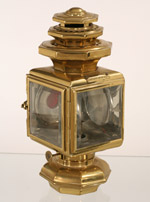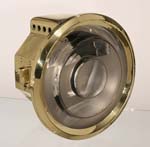|
R.E. Dietz & Co., founded in New York City in the 1840s, was known for its high-quality home and railroad lanterns. The company quickly developed oil and acetylene headlamps for the emerging automobile market. This Imperial No. 1 acetylene gas lamp was made by Dietz & Co. about 1911. ID.2001.0.109.1 |
| |
 |
| In addition to lighting the road in front of them with headlamps, automobile drivers used side lamps on their vehicles to provide additional safety lighting on dark country roads. Side lamps helped drivers see automobiles approaching from side roads. The Solar Lamp Co. of Kenosha, Wisconsin, made this side lamp about 1910. ID.68.19.354 |
| |
 |
| Pierce Arrow automobiles used large headlamps like this one supplied by the Solar Lamp Company of Kenosha, Wisconsin. These big brass lamps not only lit the road but also added to the luxurious look of an expensive automobile. ID. 68.19.248 |
|
During the late 1890s and early 1900s--when driving a car was a new and exciting form of transportation--most automobile travel was planned for daylight hours since most early cars relied on lighting carried over from the horse and buggy. Oil- and kerosene-burning front and side lamps were adequate for vehicles that moved at the speed of a walking or trotting horse. But these lamps soon proved inadequate for automobiles traveling at unheard of speeds of up to 20 or 30 miles per hour. The flames on these lamps were likely to blow out from wind or rain, and the lamps could provide light only a short distance in front of the vehicle. The combination of bigger and more powerful automobiles capable of ever increasing speeds, and the poor roads outside most cities, pushed manufacturers and consumers to look for better, safer lighting.
Acetylene Lamps
One of the great leaps forward for early automobilists was the use of acetylene gas to provide light for their vehicles. (Acetylene gas is produced when water reacts with calcium carbide.) The flame in acetylene lamps burned hot and bright even in wet or windy conditions and was less likely to blow out. When combined with a reflective lens, acetylene gas lights provided a bright white light that projected on the road over 50 feet ahead of the automobile. Also, acetylene lights proved as simple to use as traditional oil or kerosene lights. They required minimal maintenance such as cleaning the burner of built up soot or dust, and refilling the water and carbide chambers. Using these relatively safe and easy-to-use acetylene lamps, automobile drivers extended their driving time and distances outside of cities and towns and farther into the countryside.
Electric Lights
As much as acetylene lighting benefited the relatively small number of automobile drivers at the turn of the 20th century, the increasing popularity of automobiles soon put more cars on the road. Starting in the first decade of the 1900s, automobile manufacturers began looking for another alternative. They found it in a relatively new technology: electric lights. Although electrically-powered lights had been available on some early automobiles, a combination of fragile bulbs, bulky generators and heavy batteries made electrical lighting expensive and impractical for automobiles. Growing demand for better lighting on cars helped push automobile manufacturers and lighting suppliers to develop lighter, more practical electrical systems. By 1908, luxury automobile producers such as Peerless equipped their new models with standard electric lighting systems and by 1912 electric lights were offered as relatively inexpensive options by manufacturers of lower-priced automobiles. Even the inexpensive Ford Model Ts were offered to consumers with optional electric lights starting in 1915.
| |
-- Peter Kalinski, Associate Curator of Transportation |
If you would like to see how these early acetylene and electric lamps look on the road, click here to see the evening “gaslight” parade of antique vehicles at the 2007 Old Car Festival in Greenfield Village.
|
|

